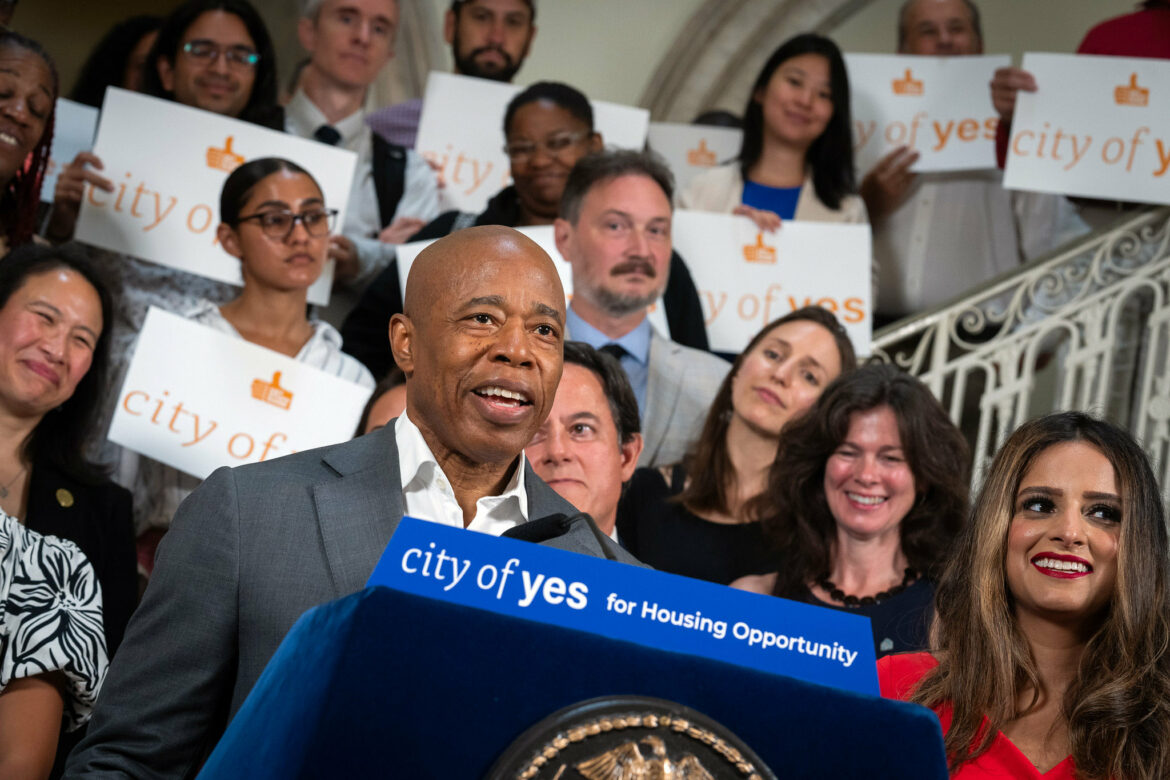
New Funding for ‘Accessory’ Apartments Touted as Tool for Housing Older New Yorkers
Officials say building more accessory dwelling units, or ADUs, can help older residents continue living in the city they helped build, and offer homeowners a way to generate income and create generational wealth by utilizing their existing spaces.
Ed Reed/Mayoral Photography Office.
Mayor Adams and other city officials announcing a new pool of funding to help homeowners build or convert ADUs.
In the middle of public review for his proposed City of Yes for Housing Opportunity (COYFHO), Mayor Eric Adams announced new tools for homeowners interested in building accessory dwelling units (ADU). They include a one-stop shop online portal to streamline the approval process, and an additional $4 million in grants to help property owners build or convert existing spaces into homes.
The mayor’s push to create more ADUs—independent units on the same lot as existing housing, such as a backyard cottage, converted garage or basement with a separate entrance—are a key part of his COYFHO proposal.
The plan would, among other zoning reforms, allow for the creation of ADUs on lots with one- or two- family residences. City officials say this will help older residents continue living in the city they helped build, and offer homeowners a way to generate income and create generational wealth by utilizing their existing spaces.
“Many of our older adults are really struggling to meet the mortgage payment, they may have lost a loved one, they may be dealing with retirement and on a fixed income,” Adams said at a press briefing Monday.
“This is a way to use your number one asset, for people in general I believe, but specifically for Black and brown people—the home,” he added. “That’s your asset. That is your foundation. That is what you build your entire financial stability after.”
There is a growing need for more housing, given the city’s historically low rental vacancy rate of 1.4 percent. At the same time, the number of older adults in New York is increasing. Those 65 and up currently represent 20 percent of the city’s residents; by 2040, their population is expected to increase by 40 percent.
There are currently 15 homeowners building or converting ADUs as part of the city’s “Plus One ADU” program in zones where they are legal (single-family homes in areas that allow for two-family homes, according to the program’s eligibility criteria). Each pilot program recipient received up to a $395,000 grant through HPD from New York State Homes and Community Renewal.
The additional funding of $4 million from the state, announced Monday, will allow another 20 homeowners who are permitted under current zoning and building codes to add or convert a secondary home. These units can be up to 800 square feet in size.
HPD’s Website
A rendering of what an accessory dwelling unit might look like.
Those interested and eligible can apply through the one-stop online portal that will be launched soon. The portal, the commissioner said, will provide information on the drawbacks and benefits of ADUs, an online library of building and architectural plans that have been vetted by the Department of Buildings to help accelerate the approval process, and connections to the construction firms that submitted those plans.
Beth Finkel, the state director of AARP, urged communities to endorse ADUs as a way to offer more housing options to its members.
“I asked you to think if this was your own mother, if this was your mother, and she was struggling and wanted to make sure she could stay in her own community, and there was a way to do this by building an accessory dwelling unit,” she said. “Maybe it’s your mother who has the home and then is able to put an accessory dwelling unit in there so that you are there, you’re there when she needs you. And this is a great opportunity.”
Allowing more older adults to remain in their neighborhoods will help the local economy, she argued, as they will use their social security and pension checks at nearby supermarkets and other shops.
Within the first few two months of opening applications for the initial 15 ADUs in the city’s pilot program in November 2023, the mayor’s office said it received 2,800 submissions.
Sade Singh, 29, a homeowner in St. Albans, Queens, was one of them, though she ultimately didn’t qualify because of current zoning restrictions. “My home falls in a location where I have strict zoning laws, so unfortunately I didn’t meet the eligibility requirements then,” she said.
Singh lives with her 57-year-old mother who is about to retire, and she is keen to convert her basement to an independent unit. That additional rental income would help “ease the burden of the mortgage,” she said.
“And then I also see the value in having a space for a family down the line, like just being part of my family’s legacy,” Singh explained.
So far, out of the city’s 59 community boards voting for COYFHO, 28 have issued “unfavorable” recommendations on the proposal, some citing concerns about new development disrupting the character of low-density neighborhoods.
At Monday’s announcement, the mayor addressed those worries. “This is not going to change a neighborhood,” he said. “You’re not going to see a 14-story building in someone’s backyard.”
If approved, out of the 100,000 homes COYFHO aims to build in the next 15 years, ADUs could represent anywhere between 26,000 to 40,000, Deputy Mayor for Housing, Economic Development, and Workforce Maria Torres-Springer said.
Following recommendations by community boards and borough presidents, COYFHO will head to the City Planning Commission for a vote, then to the City Council.
“We want to ask our partners in the City Council to say yes, we want to ask our community boards not to be afraid of this new adoption,” said Mayor Adams.
“So yes for a little more housing in every neighborhood, yes to build the future for both our grandchildren and grandparents, and yes to ADUs in the opportunity they offer.”
To reach the reporter behind this story, contact Subeksha@citylimits.org. To reach the editor, contact Jeanmarie@citylimits.org
Want to republish this story? Find City Limits’ reprint policy here.
The post New Funding for ‘Accessory’ Apartments Touted as Tool for Housing Older New Yorkers appeared first on City Limits.


